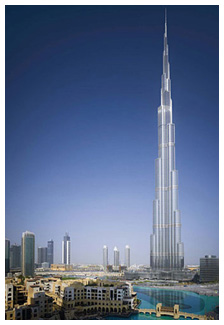 The design and construction skills, technology, mechanics and financing in parts of the world today are making it possible to create buildings that are approaching the “mile high” tower that the famous architect Frank Lloyd Wright wrote about in the 1950s. These new towers, being designed by collaborative teams taking 3-6 years in the design phase and the same to construct, are currently limited only by demand, materials and technology and stretch the limits of construction technology. Not only that, but they will have to withstand the environment for at least 50 years into the future.
The design and construction skills, technology, mechanics and financing in parts of the world today are making it possible to create buildings that are approaching the “mile high” tower that the famous architect Frank Lloyd Wright wrote about in the 1950s. These new towers, being designed by collaborative teams taking 3-6 years in the design phase and the same to construct, are currently limited only by demand, materials and technology and stretch the limits of construction technology. Not only that, but they will have to withstand the environment for at least 50 years into the future.
Today, the tallest building in the world is the 2,717-foot (829.8 meter) tall Burj Khalifa Tower in Dubai built by Besix and designed by SOM. Now Adrian Smith, (the designer of the Burj Khalifa when he was at SOM), is part of the Chicago firm Adrian Smith + Gordon Gill (AS+GG) who is designing the Kingdom Tower for Jeddah, Saudi Arabia that will top out at 3,280 feet or one kilometer tall when it is completed. A construction contract has just been awarded to the Saudi Binladen Group (SBG) for the construction expected to take over 5 years. SBG is the world’s largest construction company with over 100,000 employees.
Not only are these buildings tall, they employ more energy efficiency into their designs according to “Tall Buildings,” an article written by Peter Fairley a Paris and British Columbia based journalist, in the September/October issue of Green Source Magazine. While a 3,000-foot tall building might not be the place to undertake risky designs, the designers are forced to address structural and wind issues in the environments where the buildings are being built.
The article points out the current use of double exterior wall at the façade, recycling of condensation water, air venting to reduce wind pressures on the structure, and vertical axis wind turbines that are being used to offset part of the power load needed to keep these building running at peak efficiency are innovative. The designs are becoming more aeronautical and new materials like carbon fiber elevator cables are giving the designers and contractors the tools they need to reach ever higher into the sky.
We are wondering who will build that “OMG-tall” building that Wright envisioned over 60 years ago and what new technologies and construction skills will be necessary to make it possible?
Tall, Really Tall, Super-tall, Mega-tall, Hyper-tall and “OMG”-tall Buildings
by Jim Kollaer | October 09, 2013



Add new comment